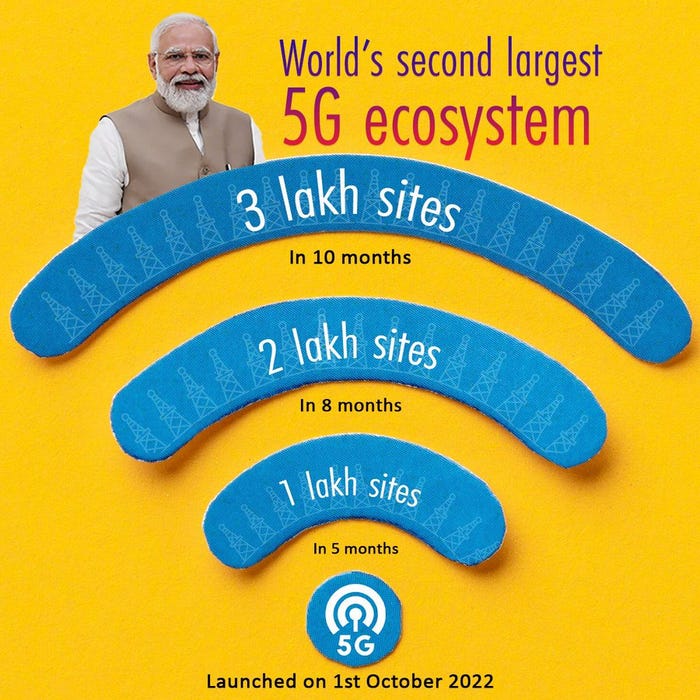India talks up latest 5G milestone
India's telecoms operators have rolled out 300,000 5G sites since the launch of the new generation of mobile technology in October last year, according to new data shared by the country's telecoms minister.
August 1, 2023

India’s telecoms operators have rolled out 300,000 5G sites since the launch of the new generation of mobile technology in October last year, according to new data shared by the country’s telecoms minister.
That’s pretty good going, particularly when you consider that those sites are essentially the work of just two telcos: Reliance Jio and Bharti Airtel.
And despite the fact that the 5G market remains the domain of only two operators, India is still laying claim to the world’s fastest 5G rollout and its second largest 5G ecosystem.
Or at least that what Ashwini Vaishnaw, India’s Minister for Railways, Communications, Electronics & Information Technology, is plastering all over social media this week.
The minister shared an infographic showing the progress India has made in 5G deployment since the technology was launched on 1 October. It took five months for the country to get to 100,000 5G sites; the second hundred thousand took another three; and just two months later – 10 months after launch – India has hit the 300,000 milestone.

That’s pretty speedy, no question about it.
It is perhaps more pertinent, at least from the operators’ point of view, to ask whether 5G customer numbers are matching the pace of rollout. Bharti Airtel racked up its first 1 million 5G customers in less than a month, although it doesn’t routinely report on 5G users. And let’s not forget that it is still not charging extra for 5G.
Meanwhile, in its most recent financial report for the three months to the end of June, Reliance Jio’s parent company Reliance Industries talked up the impact of a rapid 5G rollout on data traffic and made frequent mention of its accelerated network deployment; it aims to have finished by the end of the year, having installed more than 115,000 sites to date. But, like Bharti, it did not share 5G customer numbers.
Both operators have massive customer bases that they could upgrade to 5G. The Telecoms Regulatory Authority of India (TRAI) on Tuesday released its latest mobile statistics for the period to the end of May, revealing that between them Bharti Airtel and Reliance Jio serve just over 70% of the market. That’s a market of 1.14 billion mobile customers.
Reliance Jio and Bharti Airtel are the only ones growing their customer bases at present. Jio added just over 3 million customers in May, while Airtel claimed 1.3 million net adds. The other mobile operators – including Vodafone Idea (Vi) and BSNL which have yet to make a start on 5G rollout, although the latter seems to be getting closer thanks to hefty state bailout – all saw their subs bases shrink.
Market leader Reliance Jio had more than 436 million mobile customers at the end of May and aims to drive that number up yet further with the launch of its low-cost Jio Bharat 4G smartphone. Turning existing 2G customers in data users should help Jio to both gain customers and to create an eventual pathway to 5G usage, once devices are available and more affordable. It might not be a quick transition, but the opportunity is there.
But getting customers on to the 5G network is only part of the battle. India’s telcos also have the same challenge – albeit arguably greater – as their peers globally when it comes to monetising those 5G investments. 300,000 base stations is a remarkable figure, but there is still a long road ahead.
Get the latest news straight to your inbox. Register for the Telecoms.com newsletter here.
About the Author(s)
You May Also Like











_1.jpg?width=700&auto=webp&quality=80&disable=upscale)


.png?width=800&auto=webp&quality=80&disable=upscale)